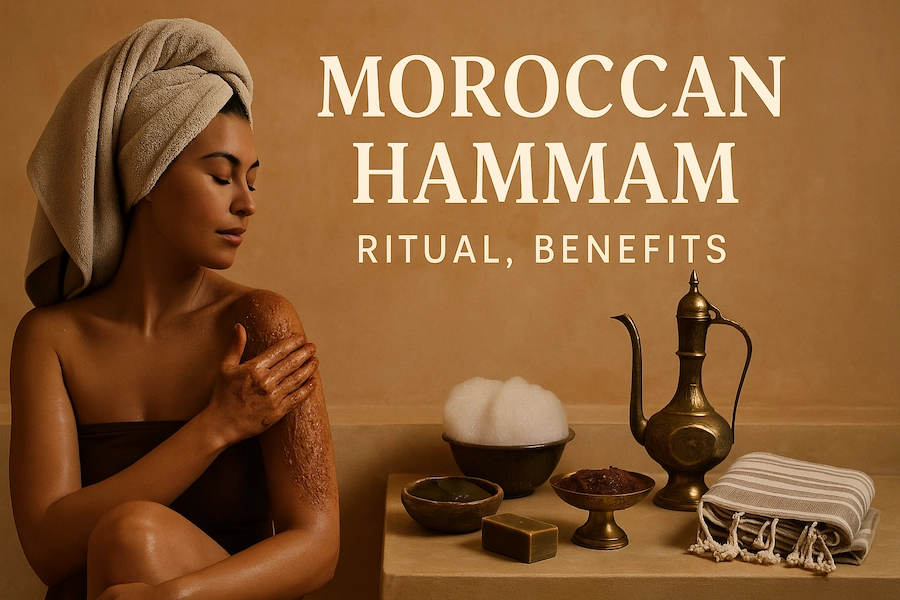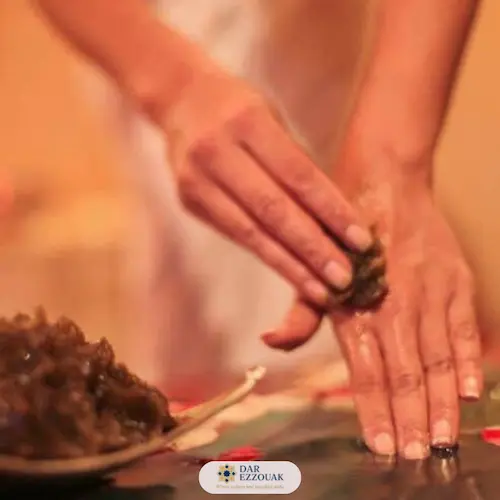Discover the Moroccan Hammam, a centuries‑old wellness ritual shaped by Roman baths and Islamic culture. More than washing, it blends steam therapy, natural ingredients, and social connection. If you’re staying near Marrakech, this guide explains the steps, benefits, etiquette, and where to try an authentic session—plus ideas to extend your trip with language lessons and Atlas Mountains excursions.

What is a Moroccan Hammam? Ritual, Benefits & Complete Guide
A visit to a Moroccan Hammam is a reset for body and mind: pores open in gentle steam, skin is purified with olive‑based soap, and tension melts away under skilled hands. Below is the full ritual and how to enjoy it like a local.
History of the Moroccan Hammam and Cultural Roots
The concept of the public bath arrived via the Romans and later expanded through the Islamic world; see the background on hammams. In Morocco, bathhouses stood near mosques so worshippers could purify before prayer. Over time, the Moroccan Hammam became part of weekly life: a social space where neighbors chat, brides prepare for weddings, and families teach good self‑care. For context on living traditions in Morocco, explore the country’s entries on the UNESCO Intangible Cultural Heritage portal.
The Moroccan Hammam Ritual: Step‑by‑Step
1) Entering the Steam Rooms (Traditional Hammam)
You start in a warm chamber where vapor slowly builds. The heat relaxes muscles, boosts circulation, and opens pores—perfect preparation for cleansing treatments.
2) Savon Noir — Black Soap Used in a Moroccan Bathhouse
Attendants apply savon noir, a creamy olive‑based paste often infused with eucalyptus. It softens the skin and lifts impurities so exfoliation can work effectively. Learn more about traditional black soap on Wikipedia.
3) Kessa Scrub: Exfoliation the Hammam Way
With a textured kessa glove, the therapist performs firm, sweeping strokes. Don’t be alarmed by the gray rolls that appear—those are dead skin cells. The result is smoother texture and a fresh glow. If your skin is sensitive, ask for a gentler pressure.
4) Rhassoul Clay Treatment from the Atlas Mountains
Next comes Rhassoul, a mineral‑rich clay from the Atlas Mountains. Applied to body and hair, it absorbs excess oils while delivering magnesium, calcium, and silica—leaving skin purified yet soft.
5) Rinse & Rest to Complete the Moroccan Hammam
After a thorough rinse, relax in a cooler room. Many venues offer mint tea or a light massage as an add‑on. Plan about 60–90 minutes for the full experience.
Benefits of the Moroccan Hammam (Backed by Spa Best Practice)
- Deep cleansing and gentle resurfacing of the skin
- Steam supports circulation and relaxation
- Muscle relief after travel or activity
- Stress reduction and mental clarity
- Naturally derived products (olive soap, clay, argan oil)
For general health guidance on steam rooms and hot environments, consult medical sources such as hospital wellness pages (e.g., Cleveland Clinic: Steam Room Benefits). Always follow your doctor’s advice if you have cardiovascular or skin conditions.

How to Prepare for a Moroccan Hammam (Etiquette & Tips)
- Bring: flip‑flops, swimsuit or wrap, and a towel (many places provide them).
- Hydrate: drink water before and after your session.
- Communicate: say if you prefer lighter pressure during the scrub.
- Timing: avoid heavy meals 1–2 hours before your visit.
- Aftercare: apply argan or almond oil to lock in moisture.
Experiencing the Moroccan Hammam in Marrakech
In Marrakech you’ll find traditional public bathhouses and modern spa versions of this steam‑bath ritual. Public venues are affordable and social; private rooms offer calm, couples’ options, and add‑on massages. If you want a base near the city while enjoying rural tranquility, consider staying at our guest house and planning a private session.
- Dar Ezzouak Guest House – Rooms & Suites
- Hammam de la Rose – Chic spa in the medina
- Les Bains de Marrakech – Luxury day spa with massages
Related Cultural Experiences Around Your Moroccan Hammam
Pair your bath ritual with activities that deepen your connection to the region:
- Learn Darija (Moroccan Arabic) to greet attendants and understand local etiquette.
- Ourika Valley & Atlas Mountains for waterfalls, villages, and scenic day trips.
- Contact us to arrange a private session, transportation, or a customized spa itinerary.
The Moroccan Hammam blends gentle heat, time‑honored products, and expert care—an ideal reset during your Morocco journey. We can help you plan the perfect session in Marrakech or nearby countryside.
Book Your Hammam Experience →FAQ — Moroccan Hammam
1) What should I bring?
Flip‑flops, swimsuit or wrap, and a towel. Many places provide these for a small fee. Tie up long hair if you’ll use Rhassoul on the scalp.
2) How long does it take?
Plan 60–90 minutes for steam, black soap, exfoliation with the kessa glove, clay application, and rest.
3) Is it suitable for sensitive skin?
Yes—with adjustments. Request lighter pressure during exfoliation and moisturize with argan oil afterward. If you have a skin or heart condition, consult a doctor first.
4) How often can I go?
Locals may go weekly; travelers usually book once during a trip. Over‑exfoliation isn’t recommended—give skin time to recover.
5) Can couples enjoy it together?
Private spas and hotels often have couple rooms. Traditional public bathhouses are usually separated by gender and schedules.
